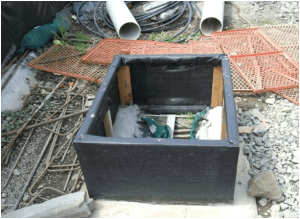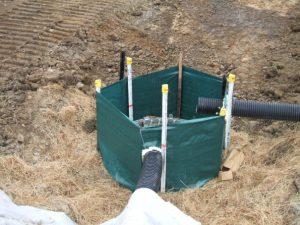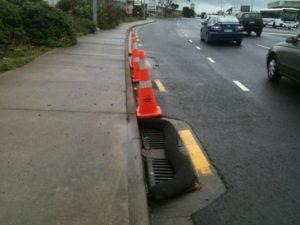Sediment Control
Stormwater inlets
What, when, why, and issues to look out for
What

Stormwater inlet protection silt fence within a construction yard. Note: Flooding is not an issue in this case (Source: SouthernSkies).
Stormwater inlet protection is a barrier across or around a catchpit, a water sensitive design (WSD) device (eg a raingarden) or any other stormwater inlet. The protection may vary according to the type of inlet it is protecting.
Why
Stormwater inlet protections intercept and filter sediment-laden runoff before it enters a reticulated stormwater system, via a catchpit, scruffy dome, manhole or WSD device. This reduces discharge of sediment-laden flows into receiving environments.
When
This is a secondary sediment control tool. It must only be used in conjunction with other erosion and sediment control tools, as part of a broader and more comprehensive ESC system.
Issues to look out for
Stormwater inlet protection has the following limitations:
- It is not a standalone treatment device.
- It should not be used in concentrated flows such as at the inlet to a culvert.
- It can have relatively low sediment removal efficiency and low sediment storage capacity.
- It has high maintenance requirements.
- There is potential for blockage of the device and, therefore, increased risk of inundation.
- The device can cause flooding to road carriageways due to its limited hydraulic capacity. Flooding can lead to public safety issues.
- The device is easily damaged by vehicles and construction equipment.
Design essentials
The following design criteria apply to stormwater inlet protection devices:
- Don’t let them block the stormwater system completely, because this will divert flows during heavy rain and may cause other devices to become overwhelmed and/or create flooding hazards
- The height of catchpit protection within live road environments must be less than the kerb height so that runoff does not cause local flooding and/or direct flows to other nearby catchments.
Silt fence

Good use of a silt fence installed to protect a new stormwater catchpit where impounded water will not create a flooding hazard.
A silt fence can be erected around the inlet.
This method is appropriate where catchpits have been connected to a stormwater system and are collecting runoff from disturbed soil surfaces within a construction site, where the retention of water will not create a flooding hazard. It is not appropriate for road maintenance or upgrade works within a ‘live’ roading situation where impounded water will create flooding issues.
Check dams
For very small catchment areas, you can install a series of low sandbag check dams up the gutter from the catchpit to act as a series of small sediment traps. The check dams need a spillway that is lower than the kerb, so that the runoff doesn’t get onto the berm and cause scouring.
Use up to six sandbags laid end to end, with no gaps, in an arc away from the kerb and up the road, to create a series of impoundment areas.
You can also make check dams from silt socks, which will provide a minor degree of filtration.
Silt socks
Place a silt sock around the inlet to act as a small sediment trap immediately upslope of the catchpit. The sock needs to completely ‘ring fence’ the catchpit.
This tool is only suitable for very small catchment areas.
Construction and operation
- Construction specifications will vary according to the type of inlet protection
- Always include an emergency bypass, and plan for where it will divert water to
- Make sure that the device doesn’t allow water to bypass its intended flow path.
Keep all stockpiles and loose sediment away from roadside table drains.
Maintenance and decommissioning
When maintaining stormwater inlets
- Maintenance will vary according to the type of inlet protection
- Inspect daily and during and after rainfall
- Check for blockages and leaks that may affect performance
- Check whether flows have been diverted away from the device and whether any damage has been caused
- Clean all accumulated sediments immediately
- Repair and modify any problems immediately.
When decommissioning stormwater inlets
- Devices must be decommissioned and removed after use
- Decommissioning will vary according to the type of inlet protection
- Remove and dispose of any accumulated sediments
- Remove control measures, then reuse and recycle the components.
